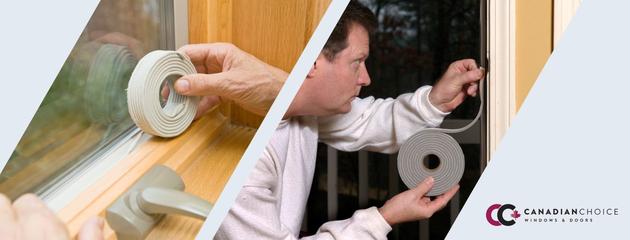Window Weather Stripping Explained

Windows play a pivotal role in our homes, allowing natural light to filter in while keeping the elements at bay. However, without proper insulation, windows can become a source of energy loss and drafts, leading to discomfort and increased utility bills.
This is where window weather stripping comes to the rescue.
The Importance of Window Weather Stripping
Window weather stripping is not just another home improvement accessory – it's a crucial element that can significantly impact your comfort and energy efficiency.
Imagine your windows as gateways that should be both inviting and protective. When windows are inadequately sealed, they can allow cold air to infiltrate during winter, causing your heating system to work overtime. Likewise, in summer, poor insulation can lead to the intrusion of hot air, prompting your air conditioning to kick into high gear.
Beyond temperature regulation, proper window weather stripping also safeguards your home from moisture infiltration. Rain and humidity can seep through gaps in windows, potentially causing structural damage, mould growth, and even compromising indoor air quality. In addition, effective weather stripping reduces noise pollution, creating a serene and peaceful living environment.
Window Weather Stripping Types and Materials
Window weatherstripping comes in various types, each catering to specific needs and preferences. The choice of material can impact the durability, effectiveness, and aesthetic appeal of the weather stripping.
- V-Strip: This classic type of weather stripping resembles the letter "V" and is often made of vinyl or metal. It's cost-effective and easy to install. V-strips are ideal for sliding windows and provide excellent insulation against drafts.
- Felt Strips: Felt weather stripping is made from compressed felt or wool and is suitable for windows that slide horizontally or vertically. While it's relatively less durable than other options, felt strips are budget-friendly and efficient for reducing drafts.
- Foam Tape: Foam tape weather stripping is self-adhesive and made from foam materials like polyurethane. It's easy to apply and works well for irregularly shaped windows. Foam tape provides good insulation and is a cost-effective solution.
- Tubular Rubber or Silicone: This type of weather stripping resembles a small tube and is often made from rubber or silicone. It's durable, works well against moisture, and is great for creating a tight seal on windows that open and close.
- Magnetic Strips: Magnetic weather stripping uses magnets to ensure a secure closure, making it ideal for windows that need to be tightly sealed. This type of weather stripping is commonly used for casement windows.
- Interlocking Metal Channels: This heavy-duty weather stripping is made from metal and is designed for maximum durability and protection. It's ideal for high-wind areas and provides an airtight seal.
Understanding Window Weather Stripping Installation
Proper installation of window weather stripping is crucial to its effectiveness.
- Clean the Surface: Before installing weather stripping, ensure the window frame and sash are clean and dry. Any debris or moisture can hinder the adhesive from sticking properly.
- Measure and Cut: Measure the dimensions of the window frame and sash accurately. Cut the weather stripping material to the appropriate lengths, leaving a slight overlap to ensure a tight seal when the window is closed.
- Apply Adhesive: For self-adhesive weather stripping, peel off the backing to expose the adhesive side. Carefully apply the weather stripping to the designated areas, pressing firmly along the entire length.
- Test the Seal: After installation, open and close the window several times to ensure the weather stripping doesn't impede the window's functionality. Check for any gaps or inconsistencies in the seal.
- Maintenance: Regularly inspect the weather stripping for signs of wear or damage. Replace weather stripping that is cracked, peeling, or no longer effective.
How Much Difference Does Weather Stripping Make?
Window weather stripping can make a significant difference in your home's energy efficiency and comfort.
By creating a tight seal around your windows, weather stripping prevents drafts, minimizes energy loss, and reduces the strain on your heating and cooling systems. Properly installed weather stripping can lead to noticeable savings on your utility bills while ensuring a more consistent and comfortable indoor temperature.
Are There Different Kinds of Weather Stripping?
There are several types of weather stripping available, each catering to specific needs and window types. Common options include V-strips, felt strips, foam tape, tubular rubber or silicone, magnetic strips, and interlocking metal channels.
The choice of weather stripping depends on factors such as the type of window, the level of insulation needed, and your budget.
Do My Windows Need Weather Stripping?
If you've noticed drafts, temperature inconsistencies, or higher energy bills, your windows might benefit from weather stripping. Additionally, if you experience moisture infiltration, noise disturbances, or difficulty in maintaining a comfortable indoor environment, weather stripping could be a solution.
Weatherstripping is particularly essential for older windows that may have deteriorated seals over time. Regularly assessing your windows' condition and consulting professionals can help you determine whether weather stripping is necessary to enhance your home's insulation and comfort.
At the end of the day, window weather stripping might seem like a small detail, but its impact on your home's comfort, energy efficiency, and protection is substantial. By choosing the right type of weather stripping and installing it correctly, you can create an environment that is cozy, energy-efficient, and free from drafts and moisture infiltration.
To ensure the best results, consider seeking professional guidance for selecting and installing window weather stripping. If you're looking for expert advice on windows and doors, Canadian Choice Windows and Doors is here to help you make the right choice for your home.
Visit us at Canadian Choice Windows and Doors today to explore a wide range of high-quality, energy-efficient windows and doors that will enhance your home's comfort and aesthetics.
1000’s of Colours & Textured Finishes
Transform your home from ordinary to extraordinary with our new coloured and non-glare textured finishes. Available in a wide array of colours as well as custom matched colours for your very own personalized design.
Our Most Popular Replacement Window Colours:








Take advantage of Canada’s Greener Homes Grant today!
Save thousands off your new window and door installation. Find out if you qualify!

